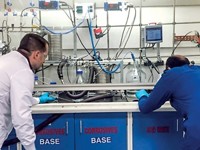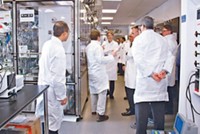Advertisement
Grab your lab coat. Let's get started
Welcome!
Welcome!
Create an account below to get 6 C&EN articles per month, receive newsletters and more - all free.
It seems this is your first time logging in online. Please enter the following information to continue.
As an ACS member you automatically get access to this site. All we need is few more details to create your reading experience.
Not you? Sign in with a different account.
Not you? Sign in with a different account.
ERROR 1
ERROR 1
ERROR 2
ERROR 2
ERROR 2
ERROR 2
ERROR 2
Password and Confirm password must match.
If you have an ACS member number, please enter it here so we can link this account to your membership. (optional)
ERROR 2
ACS values your privacy. By submitting your information, you are gaining access to C&EN and subscribing to our weekly newsletter. We use the information you provide to make your reading experience better, and we will never sell your data to third party members.
Pharmaceuticals
Continuous Flow Expert Snapdragon Takes Root
Academic spin off in Boston wants to change how drugs are made
by Bethany Halford
October 12, 2015
| A version of this story appeared in
Volume 93, Issue 40
People have recognized the promise of continuous manufacturing processes ever since Henry Ford’s auto assembly line kicked into action. Even so, pharmaceuticals are still made in batches. Proponents of continuous-flow chemistry have argued for years that assembling these molecules is not all that different from making Model Ts. With continuous flow, they say, drugs can be put together more efficiently, more safely, and with a smaller footprint.
“Nearly every major manufacturing industry, with the exception of pharmaceuticals, is continuous in nature,” says Timothy F. Jamison, a chemistry professor at Massachusetts Institute of Technology. But Jamison thinks that is beginning to change. More drugmakers, he says, are looking seriously at how to incorporate continuous-flow chemistry into their processes.
To help companies make the transition from batch to continuous flow, Jamison cofounded Snapdragon Chemistry along with Boston University chemistry professor Aaron B. Beeler and entrepreneur Sera U. Hwang. Snapdragon develops continuous-flow processes for its customers by transforming a reaction that’s been done in batches to a flow process. Snapdragon can also offer its expertise on how to do a total synthesis continuously. It even does some flow-based route scouting on a small scale.
Whereas most players in continuous-flow chemistry, such as Chemtrix and Zaiput Flow Technologies, focus on equipment or converting processes at the manufacturing scale, Snapdragon emphasizes bringing flow chemistry to drug discovery and development.
“Implementing flow chemistry in an early-stage program simply gives you more powerful tools,” Beeler says. For example, he explains, discovery and development chemists tend to avoid photochemical reactions because they’re difficult to implement in batches at manufacturing scale. But because photochemistry is easy to use in a flow chemistry system, it opens new routes in molecule making.
“We can provide that bridge between discovery and manufacturing,” Jamison adds. “Our key offering is that we’re chemists. We just have more experience with flow chemistry.”
Snapdragon incorporated a year ago and has been working steadily ever since. “We haven’t had to raise money,” Jamison says. “The only investment we’ve needed has been from our own resources.”
The company currently operates out of an incubator space at Boston University with a leadership team of five and three bench chemists. And it’s growing.
The cofounders considered 200 possible names before settling on Snapdragon Chemistry. The brainstorming process started with the word “flow.” It moved to words beginning with fl, to “flower,” and then to “snapdragon.” Retrospectively, the partners realized the word “snap” implies speed and “dragon” evokes power, two important aspects of flow chemistry.
James R. Bruno, president of the consulting firm Chemical & Pharmaceutical Solutions, says the company is nicely positioned. “Partly because of their pedigree and because continuous chemistry is becoming popular, their timing may be very good,” he says. “A lot of companies that don’t have flow chemistry at their disposal are going to look outside.”
But Bruno thinks the continuous-flow chemistry landscape could get crowded, and he wonders how many customers will sign up. “More than half of drugs are being developed by small, emerging companies,” he says. “I find them reluctant to pay for development.”




Join the conversation
Contact the reporter
Submit a Letter to the Editor for publication
Engage with us on Twitter